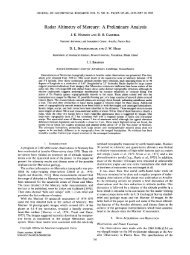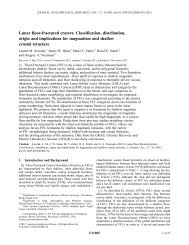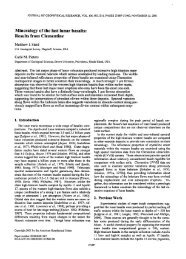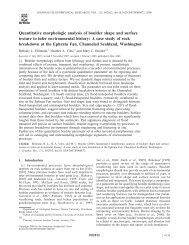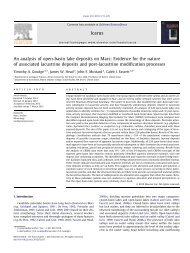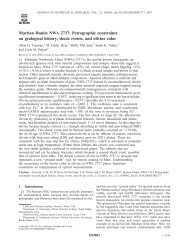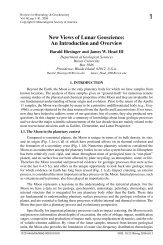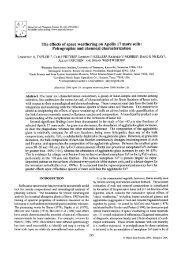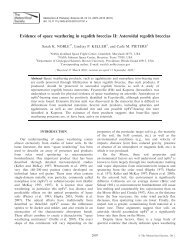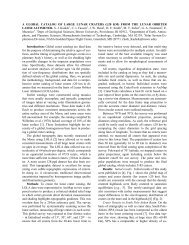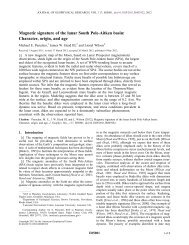Life on Mars
Life on Mars
Life on Mars
You also want an ePaper? Increase the reach of your titles
YUMPU automatically turns print PDFs into web optimized ePapers that Google loves.
<str<strong>on</strong>g>Life</str<strong>on</strong>g> <strong>on</strong> <strong>Mars</strong><br />
Although advocates of pluralism from the 17 th century <strong>on</strong> had built a case for Martian<br />
life <strong>on</strong> purely philosophical and theological grounds, it was William Herschel who first made<br />
astr<strong>on</strong>omical observati<strong>on</strong>s of the planet that were detailed enough to be relevant to the<br />
debate. From his telescopic studies in 1783, he c<strong>on</strong>cluded: 1<br />
The analogy between <strong>Mars</strong> and the earth is, perhaps, by far the greatest in the whole<br />
solar system. The diurnal moti<strong>on</strong> is nearly the same; the obliquity of their respective<br />
ecliptics, <strong>on</strong> which the seas<strong>on</strong>s depend, not very different; of all the superior planets<br />
the distance of <strong>Mars</strong> from the sun is by far the nearest alike to that of the earth . . . If,<br />
then, we find that the globe we inhabit has its polar regi<strong>on</strong>s frozen and covered with<br />
mountains of ice and snow, that <strong>on</strong>ly partly melt when alternately exposed to the sun,<br />
I may well be permitted to surmise that the same causes may probably have the same<br />
effect <strong>on</strong> the globe of <strong>Mars</strong> . . . I have often noticed occasi<strong>on</strong>al changes of partial<br />
bright belts . . . and also <strong>on</strong>ce a darkish <strong>on</strong>e, in a pretty high latitude. . . . And these<br />
alterati<strong>on</strong>s we can hardly ascribe to any other cause than the variable dispositi<strong>on</strong> of<br />
clouds and vapors floating in the atmosphere of that planet.<br />
Writing in 1870, Richard Procter 2 took Herschel’s <strong>Mars</strong>-Earth parallels further and<br />
argued vehemently for advanced Martian life based <strong>on</strong> the assumpti<strong>on</strong> that <strong>Mars</strong> was well<br />
supplied with both water and atmosphere:<br />
Shall we recognize in <strong>Mars</strong> all that makes our own world so well fitted for our wants -<br />
land and water, mountain and valley, cloud and sunshine, rain and ice, and snow,<br />
rivers and lakes, ocean currents and wind currents, without believing further in the<br />
existence of those forms of life without which all of these things would be wasted . . .<br />
it is yet to speculate ten thousand times more rashly to assert . . . that <strong>Mars</strong> is a<br />
barren waste, either wholly untenanted by living creatures, or inhabited by beings<br />
bel<strong>on</strong>ging to the lowest orders of animated existence.<br />
The astr<strong>on</strong>omical evidence seemed to c<strong>on</strong>tinue to favor life following Schiaparelli’s<br />
announcement that he had seen regular linear markings <strong>on</strong> the surface, though no <strong>on</strong>e<br />
could have imagined how far speculati<strong>on</strong> over his canali would lead. By 1892, Flammari<strong>on</strong> 3<br />
had leapt to the c<strong>on</strong>clusi<strong>on</strong> that:<br />
. . . the present inhabitati<strong>on</strong> of <strong>Mars</strong> by a race superior to ours is very probable. . . .<br />
The c<strong>on</strong>siderable variati<strong>on</strong>s observed in the network of waterways testify that this<br />
planet is the seat of an energetic vitality . . . we may hope that, because the world of<br />
<strong>Mars</strong> is older than ours, mankind there will be more advanced and wiser.<br />
In the fertile imaginati<strong>on</strong> of Lowell, this portrait of an intelligently-populated planet<br />
attained its most elaborate form. Though Lowell’s <strong>Mars</strong> was far less hospitable than<br />
Procter’s, this was seen by him as no barrier to its habitati<strong>on</strong>. On the c<strong>on</strong>trary, the<br />
difficulties imposed by the envir<strong>on</strong>ment had led the Martians to engage in such heroic<br />
hydrological schemes that evidence of them was visible from Earth. By the early years of<br />
the twentieth century, professi<strong>on</strong>al opini<strong>on</strong> was shifting inexorably away from the noti<strong>on</strong> of<br />
advanced life <strong>on</strong> <strong>Mars</strong>. Increasingly, <strong>Mars</strong> seemed too dry, airless, and cold to support<br />
anything more than primitive vegetati<strong>on</strong>. Yet, as late as 1936, <strong>on</strong>e of the founders of the<br />
British Interplanetary Society, felt able to write: 4
On <strong>Mars</strong>, the crumbling remains of ancient civilizati<strong>on</strong>s may be found, mutely<br />
testifying to the <strong>on</strong>e-time glory of a dying world.<br />
Indeed, in the very decade that the Space Age began, Willy Ley and Werner v<strong>on</strong><br />
Braun’s The Explorati<strong>on</strong> of <strong>Mars</strong> 5 c<strong>on</strong>tained a haunting illustrati<strong>on</strong> by Chesley B<strong>on</strong>estall of<br />
the ruins of a Martian temple. That dream, of finding the remnants of a l<strong>on</strong>g-dead race,<br />
quickly vanished as close-up pictures arrived in 1964 from the first successful <strong>Mars</strong> probe,<br />
Mariner 4, of a crater-strewn wilderness seemly not unlike that of our own Mo<strong>on</strong>. However,<br />
in 1971, Mariner 9 brought renewed hope of finding past and even extant biological activity,<br />
with its images of what appeared to be dried-up river channels. Such was the revival of<br />
optimism that <strong>on</strong>ly a few weeks before the first Viking landing, Carl Sagan and Joshua<br />
Lederberg went so far as to suggest 6 that: “Large organisms, possibly detectable by the<br />
Viking lander cameras, are not <strong>on</strong>ly possible <strong>on</strong> <strong>Mars</strong>; they may be favored.” In the event,<br />
nothing so spectacular was found, although the Viking result’s are still open to a variety of<br />
interpretati<strong>on</strong>s, both chemical and biological.<br />
More recently, attenti<strong>on</strong> has focused <strong>on</strong> the extraordinary possibility that life may<br />
have evolved first <strong>on</strong> <strong>Mars</strong> and then become seeded <strong>on</strong> the young Earth by the process of<br />
ballistic panspermia. 7 According to this idea, <strong>Mars</strong> afforded a safer haven for primitive life<br />
during the early, violent bombardment phase of the Solar System, between about 4.6 and<br />
3.8 billi<strong>on</strong> years ago. Whereas the Earth was probably hit repeatedly by objects up to 500<br />
kilometers across which would have vaporized the oceans and created a deadly steam<br />
atmosphere, fewer giant impacts would have taken place <strong>on</strong> <strong>Mars</strong> (because it is a smaller<br />
target) and the absence of large amounts of surface water would have saved the planet<br />
from being as severely steam-sterilized. Any Martian thermophiles living just a few hundred<br />
meters below the surface, it has been suggested, would have been able to survive the<br />
trauma of collisi<strong>on</strong> with a 500-km-wide object. Furthermore, because of <strong>Mars</strong>’ relatively cool<br />
interior and low gravity (allowing cracks, in which microbes could reside, to extend further<br />
down into the planet’s interior) thermophilic subterranean organisms may have existed in a<br />
wide habitable z<strong>on</strong>e extending to depths of several thousand meters. On Earth, by<br />
comparis<strong>on</strong>, although thermophiles 1 km below the surface might have survived an oceanboiling<br />
impact this would have left an uncomfortably narrow habitable z<strong>on</strong>e-much below 1<br />
km and microbes would probably be cooked by the planet’s hot interior. 8, 9<br />
References<br />
1. Herschel, W., “On the Remarkable Appearances at the Polar Regi<strong>on</strong>s of the Planet <strong>Mars</strong>, the Inclinati<strong>on</strong> of its Axis, the<br />
Positi<strong>on</strong> of its Poles, andf its spheroidal Figure; with a few Hints relating to its real Diameter and Atmosphere,”<br />
Philosophical Transacti<strong>on</strong>s of the Royal Society of L<strong>on</strong>d<strong>on</strong>, 74, 233 (1784).<br />
2. Procter, Richard. Other Worlds Than Ours. New York: P. F. Collier (1900) (first published 1894).<br />
3. Flammari<strong>on</strong>, Camille. La planète <strong>Mars</strong> et ses c<strong>on</strong>diti<strong>on</strong>s d’habitabilité. Paris: Gautheir Villars et Fils (1892).<br />
4. Cleator, P. E. Rockets Through Space, p. 195. New York: Sim<strong>on</strong> & Schuster (1936).<br />
5. Ley, Willy, v<strong>on</strong> Braun, Wernher. The Explorati<strong>on</strong> of <strong>Mars</strong>, New York: Viking (1956).<br />
6. Sagan, C., and Lederberg, J. “The Prospects for <str<strong>on</strong>g>Life</str<strong>on</strong>g> <strong>on</strong> <strong>Mars</strong>: A Pre-Viking Assessment,” Icarus, 28, 291 (1976).<br />
7. Sleep, N. H., and Zahnle, K. “Refugia from Asteroid Impacts <strong>on</strong> Early <strong>Mars</strong> and the Early Earth,” Journal of Geophysical<br />
Research, 103, no. E12, 28529 (1998).<br />
8. Goldsmith, D<strong>on</strong>ald. The Hunt for <str<strong>on</strong>g>Life</str<strong>on</strong>g> <strong>on</strong> <strong>Mars</strong>, New York: Penguin Books (1997).<br />
9. Hanss<strong>on</strong>, Anders. <strong>Mars</strong> and the Development of <str<strong>on</strong>g>Life</str<strong>on</strong>g>, 2 nd ed. New York: John Wiley & S<strong>on</strong>s (1997).<br />
Adapted from The Encyclopedia of Astrobiology, Astr<strong>on</strong>omy, and Spaceflight<br />
(http://www.daviddarling.info/encyclopedia/ETEmain.html)



